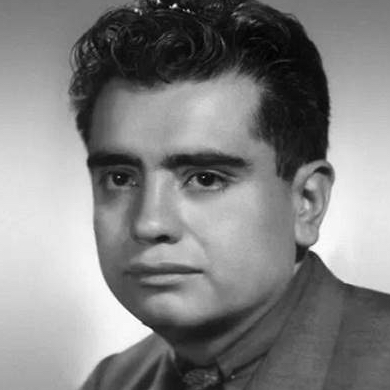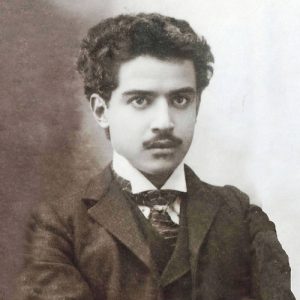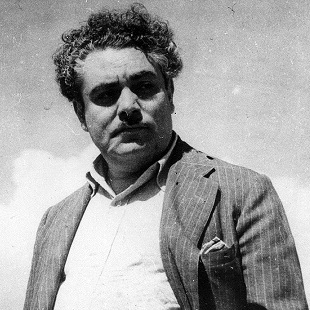Madison Symphony
Orchestra Program Notes
May
3-4-5, 2024
98th Season /
Subscription Program 8
J.
Michael Allsen
We
close this
season with the Madison Symphony Orchestra’s first-ever
all-Mexican program, beginning
with José Pablo Moncayo’s Huapango,
a joyful take on a folk dance from the state of Veracruz.
Making his debut with
the orchestra, the distinguished Mexican-born pianist
Jorge Federico Osorio
performs the lush, romantic
Piano
Concerto No.1, an early work by the Mexican master
Manuel Ponce. We then
perform the colorful—and sometimes savage—Night
of the Mayas by Silvestre Revueltas. This work will
be coordinated with
projected images assembled by the MSO’s Peter Rodgers. And
as the gran final
of this fiesta, we welcome the famed Mariachi de los
Camperos for an
exuberant set of mariachi music!
 This lively work, Moncayo’s most popular
piece, is based upon the folk music of Veracruz.
This lively work, Moncayo’s most popular
piece, is based upon the folk music of Veracruz.
José Pablo Moncayo
Born: June 29,
1912, Guadalajara, Mexico.
Died: June 16,
1958, Mexico City, Mexico.
Huapango
•
Composed:
1941.
•
Premiere:
August 15, 1941 in Mexico City,
by the Orquestra Sinfónica de Mexico,
under the direction of Carlos Chávez.
•
Previous
MSO Performances: This is our first performance of
the work.
•
Duration:
9:00.
Background
Though he had a
lamentably short career, composer José Pablo Moncayo
became one of Mexico’s leading musical figures.
Moncayo
trained in Mexico City, and became a protégé of the great
Mexican composer Carlos Chávez, but was closely associated
with the more radical Silvestre Revueltas as well. Moncayo
also studied briefly with Aaron Copland in the United
States. While still a student in Mexico City, he started
his career as a percussionist in Orquestra Sinfónica de Mexico (Symphony
Orchestra of Mexico), and he would eventually succeed
Chávez as conductor, leading the orchestra from 1949-1954.
In the 1930s, Moncayo was part of the “Group of Four”—an
influential group of like-minded young nationalist
composers who stated aim was to forward the cause of
classical works based on Mexican musical material. By far
his most popular work is the Huapango,
composed in 1941 for a commission by Chávez. Moncayo
completed the work that summer while attending the
Tanglewood Festival near Boston, at the invitation of
Copland and conductor Serge Koussevitsky.
What You’ll Hear
The fast-paced
opening and closing sections are based upon a pair of
songs from Veracruz, and the more relaxed middle section
adapts a third.
The title Huapango refers
to a folk dance associated with the son huasteca—the
lively folk music of the Mexican coastal state of
Veracruz. The huapango
is traditionally danced on a low wooden platform, so that
the dancers’ footwork can provide a percussive
counterpoint to the son.
There is a large repertoire of traditional sones, but good
singers—huasteceros—will
seldom
sing a son huasteca
the same way twice: changing melodies at will and
inserting topical references and joking asides to their
audience. In 1940, Moncayo and his friend Blas Galindo
took a folk song collecting trip to the coastal city of
Alvarado in Veracruz, and Mocayo transcribed versions of
three songs that he later adapted in his Huapango. The
bold opening section is based on two songs, El siquisiri an El balajú, with
the lively alternation between duple and triple meters
that characterizes much of Mexican folk music. A slightly
slower, more stately contrasting section adapts El gavilán, but
the tempo soon
ratchets up for a wild reprise of the opening music.
 This early work by Mexican composer
Manuel Ponce helped to
establish him as a leading figure in his homeland.
This early work by Mexican composer
Manuel Ponce helped to
establish him as a leading figure in his homeland.
Manuel
Ponce
Born:
December
8, 1882, Fresnillo, Mexico.
Died:
April
24, 1948, Mexico City, Mexico.
Piano Concerto No. 1 (Romántico)
• Composed: Ponce
completed the work in September 1910.
• Premiere: July 7,
1912 in Mexico City, with Ponce as soloist, conducted
by Julián Carillo.
• Previous MSO
Performances: This is
our first performance of the work.
• Duration:
23:00.
Background
Written
shortly after he returned from studying in Europe no
concerto is largely European in style, reflecting in
particular the influence
of Franz Liszt.
Born in
the north
central state of Zacatecas, Ponce studied music
initially with his sister,
before moving to Mexico City as a teenager to enter
the National Conservatory.
While there, his harmony teacher, Eduardo Gabrielli,
strongly encouraged Ponce
to continue his studies in Europe. He traveled to
Europe in about 1904,
studying in Milan and later in Berlin, where one of
his primary influences was
the pianist Martin Krause (who had been a disciple of
Franz Liszt). Out of
money, Ponce returned to Mexico in 1907, and
immediately threw himself into the
musical life of Mexico City, taking a teaching post at
the National
Conservatory. In the early 20th century, classical
composers across Latin
America were beginning to look towards their own
national styles for
inspiration. In Mexico, Ponce was quickly recognized
as a leading figure,
particularly after a July 1912 concert in Mexico City
that featured his Piano
Concerto No. 1, as well as several smaller
pieces that were based upon
Mexican folk styles. He followed this up with an
influential lecture on Mexican
music in 1913. From his post at the National
Conservatory (He became its
director in 1933.), and his work as a composer,
performer, musicologist, and
music critic, Ponce exerted a tremendous influence on
Mexican music for
decades.
Ponce’s Piano
Concerto
No. 1, his first large-scale composition and
only the third piano
concerto written by a Mexican composer, was quickly
nicknamed the “Concierto
Romántico.” In comparison to the more distinctly
“Mexicanist” music that
dominated his career as a composer, this is largely a
romantic, German-style
concerto influenced by Franz Liszt (by way of Ponce’s
teacher Krause), Franck,
and Chopin. However, many later Mexican writers have
pointed out subtle traces
of folk styles from his homeland.
What
You’ll Hear
In
this work, the traditional three movements of a romantic
concerto are brought together into a single, unbroken
span:
•
a stormy opening section in sonata form,
•
a lyrical interlude ending with a long cadenza, and
•
a lively conclusion
The concerto is laid out in three interconnected
movements,
beginning with a section marked Allegro
appassionato.
Written in a loosely-constructed sonata form, it begins
with a tragic main idea
from the orchestra. When the piano enters, it is with a
dramatic solo passage
and a long trill before it turns to the main theme.
Piano and solo woodwinds
introduce a lighter second idea before a stormy
development that focuses
primarily on the main theme. A short recapitulation of
this idea ends with a
short transition from the woodwinds leading into the
second movement (Andantino
amoroso). This section, the longest of the
concerto, begins with a lush
introduction, which the piano picks up in a passionate
solo. The middle section
is a sentimental pair of conversations where the piano
is answered first by
strings and then by English horn. (This passage is often
described as a
reference to a Mexican-style love duet.) A long solo
cadenza, referring to all
of the main ideas heard so far, leads into the final
section (Finale: Allegro).
This serves as an extended coda, ending with a dramatic
piano flourish.
 This work is an adaptation of a film score
by Revueltas, assembled 20 years after his death.
This work is an adaptation of a film score
by Revueltas, assembled 20 years after his death.
Silvestre Revueltas
Born: December
31, 1899, Santiago Papasquiaro, Mexico.
Died: October 5,
1940, Mexico City, Mexico.
La noche de las
Mayas (The
Night of the Mayas), arr. José Ives Limantour
•
Composed:
1939.
•
Premiere:
This music was originally
written for a 1939 film. The suite heard here was
prepared by José Ives Limantour in 1960. Limantour also
directed the first performance on January 30, 1961, by
the Orquestra Sinfónica de Guadalajara.
•
Previous
MSO Performances: This is our first performance of
the work.
• Duration: 26:00.
Background
Revueltas was a
radical—musically and politically—and created a style that
was influenced by both Mexican music and European
modernism. This clearly heard in his score to La noche de las Mayas,
which was among his final works.
Born into an
artistic family in the Mexican state of Durango, Silvestre
Revueltas trained as a violinist, composer, and conductor
in Mexico and the United States. In the late 1920s he
became a protégé of Mexico’s leading musical figure,
Carlos Chávez. When Revueltas was not yet 30, Chávez
invited him to become assistant conductor of Orquestra Sinfónica de Mexico.
After a promising start, the end of his career was much
darker. He broke with Chavez in 1936, and briefly directed
a rival national orchestra. In 1937, Revueltas left for
Spain to lend his support to anti-fascist forces in the
Spanish Civil War. He eventually fled back to Mexico when
Francisco Franco’s fascists seized total power in Spain.
Though he continued to compose, his last few years were
marked by increasing depression, poverty, and alcoholism.
He died of pneumonia at age 40. Though relatively little
known for many years after his death, Revueltas’s unique
music has enjoyed a resurgence in the past few decades.
As a
composer, Revueltas was much more interested in
contemporary European styles than most of his Mexican
contemporaries. His orchestral and chamber music was often
a blend of modernist techniques with a huge array of
Mexican musical influences. He brought this same approach
to several film scores written between 1935 and 1939. The
last of these was for the 1939 film La noche de las Mayas,
directed by Chano Uruete. This was a drama centering on an
isolated community of Maya Indians in Mexico’s Yucatán
jungle, and the disastrous result of their encounter with
modern culture, in the guise of a white explorer who finds
the tribe. Revueltas’s score uses a variety of indigenous
melodies, and a range of percussion instruments from the
region. Revueltas died before he could create a concert
version of this music. German composer Paul Hindemith
created a concert suite from selections from Revueltas’s
score in 1946. However, the 1960 version by conductor José Ives Limantour is how the
score is usually heard today. Limantour took a very free
hand in arranging over 30 of Revueltas’s brief musical
cues for the film into a large four-movement suite. The
suite uses a fairly standard orchestra but an enormous
percussion battery in the final movement, requiring
twelve players. It calls for several indigenous
instruments, including caracol (conch
shell), sonajas
(metal rattles), teponaxtles
(large hollow wooden “slit drums”), and huehuetl (a
large bass drum).
What You’ll Hear
This concert
suite, arranged by José Ives
Limantour, is in four movements:
• Noche de los Mayas begins
and
ends calmer episode in the middle of the movement.
• Noche de los Jarana
is more lighthearted, set above a dance rhythm.
• Noce de Yucatán is
a calm piece of “night music” with hints of darkness.
• Noche de
encantamiento is where Limantour unleashes the full
percussion battery. Most of the movement is a series of
variations on a theme heard at the opening.
The opening
movement, Noche de
los Mayas, begins
with a threatening fanfare—1930s “movie music” of the most
dramatic kind. This is followed by a more relaxed episode
and quietly repetitive music from the woodwinds that
evokes indigenous melodies. The movement ends with a
reprise of the opening music. Noche de los Jarana
is a much lighter scherzo. (Jarana is slang
for a drunken party.) The frantic forward motion never
stops, as music flits between various meters. The strings
act as timekeepers, as brass and woodwinds interject
contrasting ideas: a mournful conch-shell call from the
tuba, a brief attempt to upset the strings’ rhythm, and a
slightly tipsy but quick-footed dance from the brass. Noce de Yucatán
begins with lyrical and sometimes tense music, evoking the
surrounding jungle. This is interrupted briefly by a short
interlude for solo flute and drums: an indigenous melody
borrowed by Revueltas. The opening mood returns at the
bend, but is shattered by a sudden percussive crack that
begins the last movement, Noche de
encantamiento (Night
of enchantment). The oboe lays out a theme used
throughout the movement, followed by an angry response
from the strings and brass. The rest of the movement is a
set of four increasingly ferocious variations on the
opening theme, dominated entirely by the percussion. These
percussion parts, meant to sound improvised, were added by
Limantour, and are not part of Revueltas’s film score. The
movement ends with a savage coda.
________